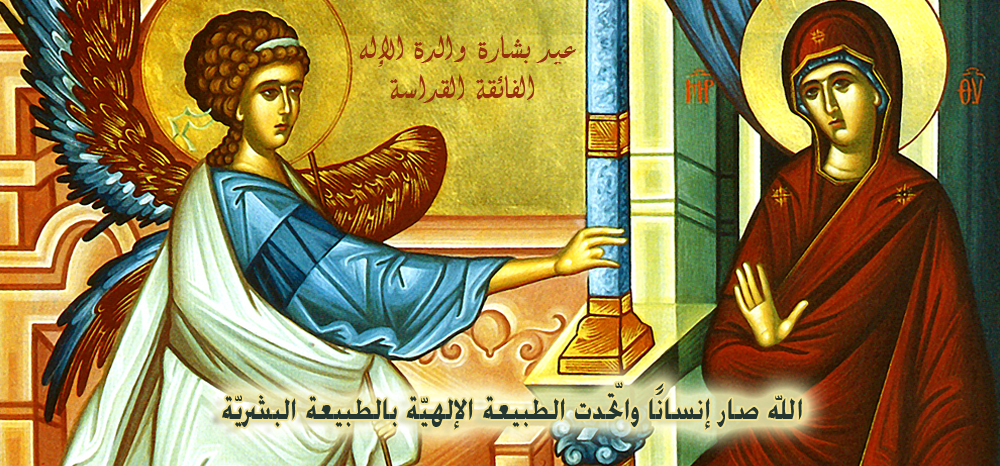
The Annunciation of the Lord
The Annunciation of the Lord
1-Definition:
“The annunciation is a song of joy that opens the door to the mystery of divine salvation.”
The Feast of the Annunciation is the Feast of the Divine Incarnation (Christmas is the Feast of the God’s manifestation in the flesh).
The angel Gabriel preached the conception of the Virgin Mary from the Holy Spirit, and announced that the Creator wished to be incarnate without any change in His divinity. The Annunciation came about: the divine nature was united with human nature.
- The roots of the feast go back to the early centuries of Christianity.
The topic of the virginity of Mary the Mother of God and her divine conception, i.e., the incarnation of God in the womb of a woman, has occupied the whole world ever since the old days. It has changed the face of history, and set ablaze the hearts that awaited eternal salvation.
However, some people rejected the event altogether, for they wondered how it could be possible for God to be incarnate, and how the Creator could unite with the creature.
Hence, Christianity confidently replies through the holy fathers of the church and asks: Is it impossible for the One who is the Source of love to unite with humans whom he created in His image and called to be in His likeness? How could God love humans if He remained in the heights above and was not incarnate?
Would the Unchangeable change by uniting with humankind? Or is it that humankind will change and be deified with the divine grace by uniting with God? Is it possible for the Heavenly Father to remain far away from His children?
All these answers in question form put forth the following statement: it is important to know to whom the Archangel Gabriel preached. But what is more important is to realize and understand about whom Gabriel was preaching.
The best answer to this question which summarizes the meaning of the feast, is what the Church announces in her Creed: “True God of True God, Begotten not Made”.
2- The faith of the early Christian communities:
Before acknowledging the Creed in the first Ecumenical Council in Nicaea, in 325, with its completion in the second Ecumenical Council in Constantinople in 381, there had been in different places, several confessions of faith adopted by the Christian communities in their prayers. It is worth mentioning that in these confessions have in common two main subjetcs:
- The divine conception
- God becoming man; His birth in the flesh.
This clearly reflects the Christian faith from its inception.
The exceptional and extraordinary event that took place in history once, I mean the unity between the divine and the human natures, which is the basis of the Christian faith and the starting point of all Christian dogmas. Overlooking over this mystery is a literal heresy in Christianity.
All the seven Ecumenical Councils that took place in the first millennium were to announce and confirm the incarnation of God and His birth in the flesh of the Holy Spirit and the Virgin Mary, the Theotokos.
Since God was incarnate, I mean that He became like one of us, we write His icon to assert His incarnation.
The expression “He was incarnate of the Holy Spirit, and the Virgin Mary” is most ancient terminology in Christianity. It is even characteristic of the Christian faith, and is an indispensable common principle. For this reason, the more correct translation of homoousios which relates to the essence of the Son, is “of one essence with the Father” which is better than the usual “consubstantial to the Father”.
The Son is begotten of the Father; He is the Eternal Word incarnate who came and dwelt among us; He is of the essence of the Father (ek tis ousias tou patros).
3- The date and development of the feast:
The feast of the Annunciation in the early church was not an independent; it was connected to Nativity, which in turn was connected to the divine Epiphany.
When Nativity, which in fact is the appearance of God in the flesh, was separated from the Epiphany in the 5th century, the need for a private date for the Annunciation started to be important where readings and prayers related to the feast and its theology, can be read.
Note:
The feast of the Annunciation falls on March 25, in time with the Spring Equinox where the hours of the day and the night are equal. The ancient civilizations used to believe that the world and man were created on this day.
St. Anastasius of Antioch (599) wrote the following:
“God in wisdom created everything, and in order and moderation He let the creation come into being, inaugurating time. He also wanted to come during the same period of time in which He created the world and the creatures.
After the Spring Equinox on March 20, when the days and the nights are equal, comes the sixth day on which man was created.
This was March 25. On this day God and man got perfectly united.
St. Maximus the confessor says (622):
“What hour and month did the Annunciation take place?
He answers: “The Virgin was fasting, and she used to go on foot to pray, for she found in God the fountain of her life. This took place in the first month, I mean the month when God created the world. This event aimed to teach us that in this day He is vivifying and renewing the ancient world.
This was on the first day of the week, “Sunday”, the day on which darkness was conquered and light was created; it was the first creature.
That Sunday is also the day when the light of the resurrection broke out, announcing the resurrection of the Lord, and our resurrection with him.
And as on Sunday God renewed our nature when He became incarnate in the womb of the Virgin, so on Sunday too we were raised from our sins with his glorious resurrection.
Not only on the first day, but also in the first hour after the break out of dawn through the darkness of night to announce with the Psalmist: “God shall help her, just at the break of dawn” (Psalm 46:5).
It is a psalm that expresses great confidence in God at times of trouble and calamities.
This feast overflows with the joy that is expressed in the Troparion as well as in the prayers of the service: the readings, chanting, and sermons.
The troparion of the feast:
Today is the beginning of our salvation, and the manifestation of the mystery from the ages; for the Son of God becometh the Son of the Virgin, and Gabriel proclaimeth grace. Wherefore, do we shout with him to the Theotokos: Hail, O full of grace! The Lord is with thee.
This feast is the feast of encounter between heaven and earth. It inaugurates all the coming encounters that follow. This made the church think of a way to collect and put the liturgy of the feast in accord with the paschal journey of Lent.
So the council of Trullo in 692 came to translate the faith of the church by decreeing to keep core of the feast untouched because of its great importance in the Christian faith and allowing the celebration of the divine liturgy and Holy Communion even when the feast falls on Holy Friday.
Note:
The church has arranged the transfer of the feast in the churches of the cities and villages when it falls on the great Friday and on the Bright Saturday so that people won’t get and confused.
But in the monasteries the feast is celebrated on time.
- The readings in the Orthodox Church have been arranged in a way that suits the core of the feast and the paschal journey.
In the west, things were a bit different, for the council of Toledo 656 decided to celebrate the feast on December 18 together with the 25 of March, and this was observed in Rome too. But in the 17th century with the calendar change and the desire to remove repetition, the feast remained on March 25.
It has been told of a great and gorgeous celebration by Pope Sergius I (687-701) in Rome; the Pope is Italian, descendant from Syria. He started a candle-procession accompanied by prayers in the Basilica of Santa Maria-Maggiore in Rome which has a fresco of the divine incarnation that clearly manifests the Virgin as Mother of God (Theotokos) according to what had been mentioned in the 3rd Ecumenical Council of Ephesus in 431.
4- Resources of the feast:
The feast includes besides the text from Luke, (1:26-38), some patristic writings with the apocryphal Protogospel of James.
But the text from Luke occupies the first place in the formation of the feast, especially the dialogue between the Virgin Mary and Archangel Gabriel:
“The Holy Spirit will come upon you, and the power of the Highest will overshadow you; therefore, also, that Holy One who is to be born will be called the Son of God”.
After reading the text from Luke and meditating upon it, word by word, the holy fathers raised two questions:
- Why was the Annunciation to a young engaged virgin?
- Why was Mary worried after Archangel Gabriel had talked to her?
- To answer the first question, we read what St. Ignatius of Antioch (115) wrote in his epistle to the Ephesians:
“The chief of this world did not recognize the virginity of Mary, her birth, and the death of the Lord. Three great mysteries had been performed by God in quiet and silence.”
The mystery of the conception of the virgin Mary has its own wisdom, for the young girl had to be engaged to a man, in order that she be honored and not exposed publically by the Jews, for the act would be exploited by the evil one, and Mary would be stoned to death with regard to the Law, because of adultery and fornication.
On the other hand, it is not by chance that Mary’s fiancé should be pious and righteous, for Joseph was to guard the one to whom this divine mystery.
- We read in Origen’s writings (184-253) several interpretations similar to the above-mentioned, with similar context.
As concerning the second question, Origen answers that the angel’s speech with the Virgin Mary is has no precedent or even presence in the scriptural texts of the prophets or the Law. And this is enough.
- At the same time Sophronius the Patriarch of Jerusalem explains the event in details and says:
“The virgin Mary was pure in thought and chaste in her soul that is why she remembered the satanic seduction against Eve, and the fall that followed, besides losing divine grace.”
And before Sophronius the patriarch of Jerusalem, blessed Augustin (354-430) asserts that Mary wished to be a virgin for the Lord. He even drifted and said: “Even before Mary was born, God wanted to choose a dedicated virgin from whom he would be incarnate.”
The Orthodox Church, from the beginning, thought these words (of Augustine) to be imprecise. Besides, it would make way to fall in the so-called divine predestination; consequently, human destiny would predetermined, not free. Thus, humans lose freedom the act that is contrary to the divine nature.
Scholars generally agree that these thoughts gave birth later to the so-called “predestination” dogma in the Latin Church, to the “Original sin”, and, consequently, to the dogma of “the Immaculate Conception”.
5- St. Romanos the Melodist (6th century) describes in a poetic way how Mary told Joseph her fiancé about the meeting with the angel: “Where have you been guard of my virginity?” “Where have you been, righteous and devout one? A flying figure passed by and granted me the grace of engagement, as jewels to my ears. And his words were like earrings. His salutation that had been blown strongly into my ears enlightened me and made me a mother (Like an earring of gold and an ornament of fine gold is a wise rebuker to an obedient ear. Proverbs 25:12).
“I could not understand how I was to conceive, but now I am a mother before your eyes without losing my virginity, because you knew me not.”
Note:
The jewels and the earrings reflect images of the conception in ancient civilizations that life comes to man through his ears. And some of these images have been grasped by some Christians:
- Tertullian (220-230) also explains:
“Life walked into Eve by means of hearing. And so did the deadly words of the evil one. In that he sets a beautiful comparison before us:
Eve:
- Eve listened to the serpent and fell.
- Eve, given the words of God, squandered them listening to the serpent.
- And listening to the words of the evil one and believing him, gave birth to a barren fruit which is death.
- The fruits of the evil one are:
Separation, torture, and death with killing (Cain & Abel).
Mary the mother of God (the Theotokos): - The Virgin Mary listened to the angel and she was lifted high.
- The sin, to which the first Eve listened, was squandered and dispersed by Mary the mother of God upon listening to the word of God.
- Listening to the word of God and believing it (with confidence), gave birth to the Life-giving fruit, I mean the Lord of Life Jesus Christ.
- The Virgin Mary gave birth to the savior who granted life and conquered death by his death.
- St. Ephraim the Syrian (373) explains in his Diatessaron:
“Since death came to Eve through her ears, life had to come to Mary through her ears too. Consequently, to the whole world through hearing and listening. Talk Lord, your servant is listening.”
This means that one accepts the word of God in full freedom or vice versa. And the Virgin Mary fully free accepted the words of God given to her.
In addition to these, we find many interpretations in the writings of the holy fathers and saints like Athanasius of Antioch (599), Sophronios of Jerusalem (638), and Andrew of the Crete (740). St. John of Damascus (749) says: “Conception of the Divine Son came through listening, but deliverance came through the natural canal. It was not impossible for God to walk out through the natural door without tearing its seals”.
In conclusion, we say:
The feast of the annunciation is the feast of salvation; it is the feast of union between God and humankind, the feast of love and joy. Shouldn’t we rejoice and be delighted by that?”

2025-12-09
Patriarch JOHN X’s Address at…
2025-12-06
2025-12-04
Celebrating the Feast of Saint…
2025-12-01
Address of Patriarch JOHN X The…
2025-11-24
Delegation from the Hungarian…







